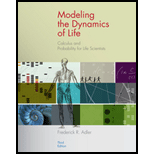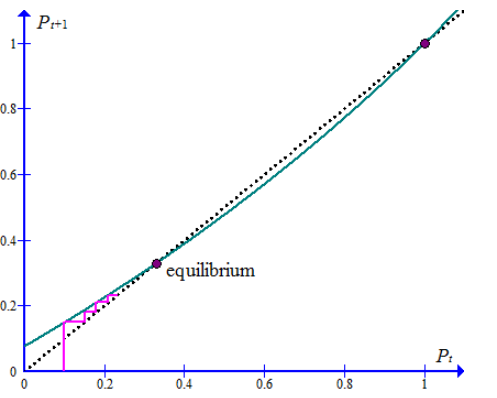
a
To calculate: To find the number of wild-type bacteria that mutates using the given information
a
Answer to Problem 31E
The number of wild-type bacteria that mutate is
Explanation of Solution
Given information: Suppose that a fraction 0.1 of wild-type mutate each generation, but that each wild-type individual produces 2.0 offspring while each mutant produces only 1.5 offspring.
Calculation:
Initially, let there be
Now a fraction 0.1 of wild-type mutate each generation.
Therefore, the number of wild-type bacteria that mutate is
b
To calculate: To find the number of wild-type bacteria and the number of mutants after mutation using the given information
b
Answer to Problem 31E
The number of mutants after mutation is given by
Explanation of Solution
Given information: Suppose that a fraction 0.1 of wild-type mutate each generation, but that each wild-type individual produces 2.0 offspring while each mutant produces only 1.5 offspring.
Calculation:
Now the number of wild type bacteria after mutation is given by
Also, the number of mutants after mutation is given by
c
To calculate: To find the number of wild-type bacteria and the number of mutants after reproduction using the given information
c
Answer to Problem 31E
The number of mutants after reproduction shall be
Explanation of Solution
Given information: Suppose that a fraction 0.1 of wild-type mutate each generation, but that each wild-type individual produces 2.0 offspring while each mutant produces only 1.5 offspring.
Calculation:
Now, each wild-type individual produces 2.0 offspring.
Therefore, the number of wild-type bacteria after reproduction is given by
Also, each mutant produces only 1.5 offspring.
Therefore, the number of mutants after reproduction shall be
d
To calculate: To find the total number of bacteria after mutation and reproduction using the given information
d
Answer to Problem 31E
The total number of bacteria after mutation and reproduction is given by
Explanation of Solution
Given information: Suppose that a fraction 0.1 of wild-type mutate each generation, but that each wild-type individual produces 2.0 offspring while each mutant produces only 1.5 offspring.
Calculation:
The total number of bacteria after mutation and reproduction is given by
e
To calculate: To find the fraction of mutants after mutation and reproduction using the given information
e
Answer to Problem 31E
Explanation of Solution
Given information: Suppose that a fraction 0.1 of wild-type mutate each generation, but that each wild-type individual produces 2.0 offspring while each mutant produces only 1.5 offspring.
Calculation:
To find the fraction of mutants after mutation and reproduction, divide the discrete-time dynamical system for
Therefore, we have
f
To calculate: To find the equilibrium using the obtained values
f
Answer to Problem 31E
Explanation of Solution
Given information: Suppose that a fraction 0.1 of wild-type mutate each generation, but that each wild-type individual produces 2.0 offspring while each mutant produces only 1.5 offspring.
Calculation:
Let
To find the equilibrium consider,
Solving the above equation gives,
Therefore,
g
To calculate: To determine and to find whether the equilibrium is stable or not using the obtained information
g
Answer to Problem 31E
The equilibrium at l/ 3 seems to be stable. The fraction of mutants will end up at about 33.33 percent.
Explanation of Solution
Given information: Suppose that a fraction 0.1 of wild-type mutate each generation, but that each wild-type individual produces 2.0 offspring while each mutant produces only 1.5 offspring.
Calculation:
The cobweb starting from the initial condition is as shown below:

The equilibrium at l/ 3 seems to be stable. The fraction of mutants will end up at about 33.33 percent.
Want to see more full solutions like this?
Chapter 1 Solutions
Modeling the Dynamics of Life: Calculus and Probability for Life Scientists
 Trigonometry (MindTap Course List)TrigonometryISBN:9781337278461Author:Ron LarsonPublisher:Cengage Learning
Trigonometry (MindTap Course List)TrigonometryISBN:9781337278461Author:Ron LarsonPublisher:Cengage Learning
